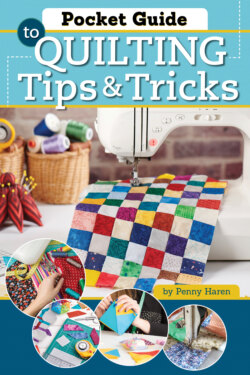Читать книгу Pocket Guide to Quilting Tips & Tricks - Penny Haren - Страница 6
На сайте Литреса книга снята с продажи.
Organizing Your Space
Оглавление1 Hanging Projects
Many of us have a closet in our sewing room. Hang your projects on the rod in vinyl mesh bags with “S” hooks. These bags come in a variety of sizes—large enough to hold a book and everything you need to make the project. You can literally hang over 100 projects vertically—easy to see and easy to find!
2 Folding Tables
If you use folding tables in your sewing room, consider two 4' (1.22m) tables instead of an 8' (2.44m) table. The shorter length makes it more stable and less likely to vibrate when sewing.
3 Cutting Tables
Design your cutting table so that it is the appropriate height for you. Kitchen counter height is ideal for someone who is of average height—approximately 5' 4" (1.63m) for women. Adjust accordingly.
4 Stash
Organize your stash by type rather than color. Then when you are ready to make a scrappy project, simply pull out the bin of country fabrics, batiks, brights, backgrounds, Asian prints, pastels, etc. and start cutting. Everything in the bin will go together!
5 Background Fabric
If you are uncomfortable choosing fabrics for scrap quilts, use the same background fabric for the entire quilt. It gives your eyes a place to rest and gives a more controlled look.
6 Distributing Colors Evenly
When making scrap quilts over a period of time—and in my case, sometimes years—wait to put the blocks together so that the colors will be distributed evenly throughout the quilt. The shades of popular colors change from year to year. (Moss green is popular one year, evergreen the next.)
